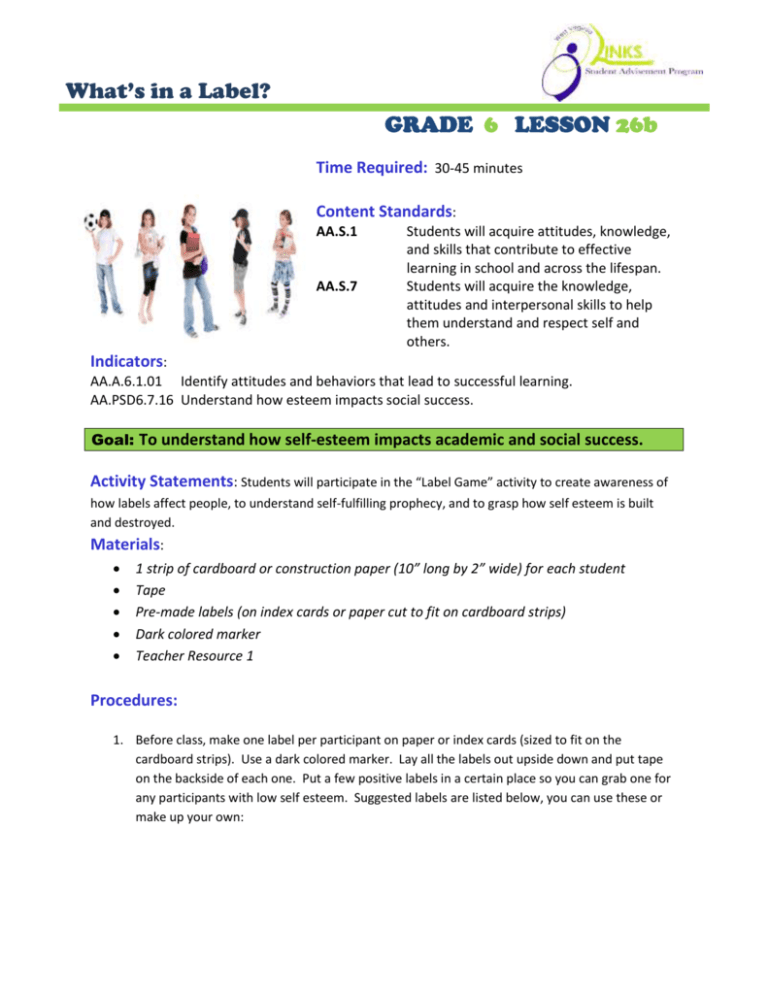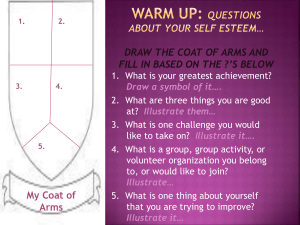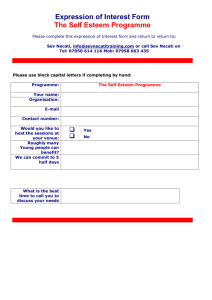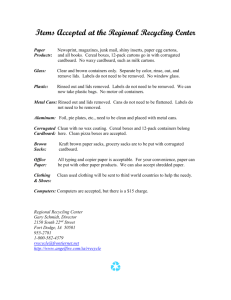What`s in a Label?
advertisement

What’s in a Label? GRADE 6 LESSON 26b Time Required: 30-45 minutes Content Standards: AA.S.1 AA.S.7 Students will acquire attitudes, knowledge, and skills that contribute to effective learning in school and across the lifespan. Students will acquire the knowledge, attitudes and interpersonal skills to help them understand and respect self and others. Indicators: AA.A.6.1.01 Identify attitudes and behaviors that lead to successful learning. AA.PSD6.7.16 Understand how esteem impacts social success. Goal: To understand how self-esteem impacts academic and social success. Activity Statements: Students will participate in the “Label Game” activity to create awareness of how labels affect people, to understand self-fulfilling prophecy, and to grasp how self esteem is built and destroyed. Materials: 1 strip of cardboard or construction paper (10” long by 2” wide) for each student Tape Pre-made labels (on index cards or paper cut to fit on cardboard strips) Dark colored marker Teacher Resource 1 Procedures: 1. Before class, make one label per participant on paper or index cards (sized to fit on the cardboard strips). Use a dark colored marker. Lay all the labels out upside down and put tape on the backside of each one. Put a few positive labels in a certain place so you can grab one for any participants with low self esteem. Suggested labels are listed below, you can use these or make up your own: What’s in a Label? GRADE 6 LESSON 26 Natural Leader Extremely Creative From the “Wrong Side of the Tracks” Hyperactive Beauty Queen Everything I Say is Funny Very Shy Airhead Jock Nerd Brainiac Wealthy Bossy Very Hostile or Angry Invisible Pushover Troublemaker Computer Geek Loser Drama Queen 2. Give each student a strip of cardboard and a piece of tape. Have students wrap cardboard strip around their heads (going across the forehead) and hold the spot where it fits comfortably. Next, tell them to pull it off and secure the spot with the tape. Now they should place the cardboard strips back on their heads (they should look like they are wearing funny headbands). 3. Have students arrange their chairs in a tight circle. They need to be able close enough to read the labels on other participants “headbands”. 4. Read the story in the teacher resource you feel fits best with your students (or summarize it in your own words) or make up a scenario of your own. 5. Place labels on students’ headbands and give the group 10 minutes to discuss the situation you presented. At first, observe. If the group is moving slowly, join in to get things going. Start by looking directly at the person labeled “Natural Leader” and say something like, “We are looking to you to see what you think we should do.” Whatever idea he or she presents, support it and tell the group they should too. If the person with the “Invisible” label says something, you must persuade the group to ignore it. You may want to say something like “Did you hear something? I thought I did but I guess not.” Sometimes the teacher’s participation in the activity is vital to make it work, other times groups will run with it and it’s better to observe. 6. After the group has had several minutes of discussion, break in and ask them to each state one idea on how to spend the money. Be sure that you and the rest of the group respond to each person based on his or her “label”. After each person contributes have them guess what their label is. 7. If time permits you can repeat the entire process using a different scenario and re-labeling the students. Discussion: Many participants report being deeply affected by this activity. This exercise can be a wonderful example of a self-fulfilling prophecy and how it can destroy a relationship. For example, if someone is By: Iestyn Bright, Counselor, WVDE (2010) What’s in a Label? GRADE 6 LESSON 26 constantly ignored or feel invisible they will start acting as if they are not important and quit trying to interact with others. The student who was labeled “invisible” may even say “I just quit talking because everyone was ignoring me”. This can lead to the discussion about the importance of self esteem and how damaging labels can be on your self esteem. It can also be used to talk about why we label each other and what effect it has on others. What do you think this exercise was about and how does it relate to sixth graders? How did it feel to be labeled? If you had a positive label, how did you feel about the exercise? (Surprisingly, the “good” labels often come with a lot of pressure, so they are not always a positive experience) Did the way others were treating you change your behaviors? (for example, some people stop talking, some people talk more, etc.) How hard was it to find proof of each person’s label? (look for the label instead of how the person truly is) What other labels can people receive when growing up or as an adult? How do labels affect your self esteem? How do labels affect your relationship with others (family, friends, teachers, etc.)? How does your self esteem affect your academics or grades? Additional Resources: http://kidshealth.org/teen/your_mind/mental_health/self_esteem.html - ways to improve selfesteem. http://discoveryhealth.queendom.com/self_esteem_abridged_access.html - self esteem test tells you whether you have a high or low self-esteem and ways to increase it. www.selfesteemawareness.com – defines and gives examples of self-esteem. Extension Activities: 1. Ask students write a paragraph or journal article identifying their own sources of good self esteem. 2. Ask students to make a list of behaviors that lead to success in academics, relationships, sports, and physical appearance. Adapted from: http://www.healthymarriageinfo.org/docs/facilitator_toolkit/LabelGame.pdf By: Iestyn Bright, Counselor, WVDE (2010)







